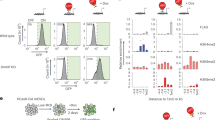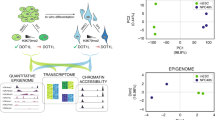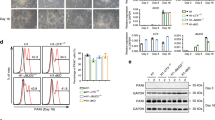Abstract
A series of transcription factors critical for maintenance of the neural stem cell state have been identified1,2,3, but the role of functionally important corepressors4,5,6,7 in maintenance of the neural stem cell state and early neurogenesis remains unclear. Previous studies have characterized the expression of both SMRT (also known as NCoR2, nuclear receptor co-repressor 2) and NCoR in a variety of developmental systems8; however, the specific role of the SMRT corepressor in neurogenesis is still to be determined. Here we report a critical role for SMRT in forebrain development and in maintenance of the neural stem cell state. Analysis of a series of markers in SMRT-gene-deleted mice revealed the functional requirement of SMRT in the actions of both retinoic-acid-dependent and Notch-dependent forebrain development. In isolated cortical progenitor cells, SMRT was critical for preventing retinoic-acid-receptor-dependent induction of differentiation along a neuronal pathway in the absence of any ligand. Our data reveal that SMRT represses expression of the jumonji-domain containing gene JMJD3, a direct retinoic-acid-receptor target that functions as a histone H3 trimethyl K27 demethylase and which is capable of activating specific components of the neurogenic program.
This is a preview of subscription content, access via your institution
Access options
Subscribe to this journal
Receive 51 print issues and online access
$199.00 per year
only $3.90 per issue
Buy this article
- Purchase on Springer Link
- Instant access to full article PDF
Prices may be subject to local taxes which are calculated during checkout




Similar content being viewed by others
References
Guillemot, F. Cellular and molecular control of neurogenesis in the mammalian telencephalon. Curr. Opin. Cell Biol. 17, 639–647 (2005)
Hsieh, J. & Gage, F. H. Epigenetic control of neural stem cell fate. Curr. Opin. Genet. Dev. 14, 461–469 (2004)
Ross, S. E., Greenberg, M. E. & Stiles, C. D. Basic helix-loop-helix factors in cortical development. Neuron 39, 13–25 (2003)
Chen, J. D. & Evans, R. M. A transcriptional co-repressor that interacts with nuclear hormone receptors. Nature 377, 454–457 (1995)
Horlein, A. J. et al. Ligand-independent repression by the thyroid hormone receptor mediated by a nuclear receptor co-repressor. Nature 377, 397–404 (1995)
Nishihara, E., O'Malley, B. W. & Xu, J. Nuclear receptor coregulators are new players in nervous system development and function. Mol. Neurobiol. 30, 307–325 (2004)
Hermanson, O., Jepsen, K. & Rosenfeld, M. G. N-CoR controls differentiation of neural stem cells into astrocytes. Nature 419, 934–939 (2002)
Jepsen, K. et al. Combinatorial roles of the nuclear receptor corepressor in transcription and development. Cell 102, 753–763 (2000)
Campbell, K. Dorsal-ventral patterning in the mammalian telencephalon. Curr. Opin. Neurobiol. 13, 50–56 (2003)
Akiyama, H. et al. The role of transcriptional corepressor Nif3l1 in early stage of neural differentiation via cooperation with Trip15/CSN2. J. Biol. Chem. 278, 10752–10762 (2003)
Anderson, S. A. et al. Mutations of the homeobox genes Dlx-1 and Dlx-2 disrupt the striatal subventricular zone and differentiation of late born striatal neurons. Neuron 19, 27–37 (1997)
Ribes, V., Wang, Z., Dolle, P. & Niederreither, K. Retinaldehyde dehydrogenase 2 (RALDH2)-mediated retinoic acid synthesis regulates early mouse embryonic forebrain development by controlling FGF and sonic hedgehog signaling. Development 133, 351–361 (2006)
Halilagic, A. et al. Retinoids control anterior and dorsal properties in the developing forebrain. Dev. Biol. 303, 362–375 (2007)
Park, J. I., Tsai, S. Y. & Tsai, M. J. Molecular mechanism of chicken ovalbumin upstream promoter-transcription factor (COUP-TF) actions. Keio J. Med. 52, 174–181 (2003)
Cohen, R. N., Putney, A., Wondisford, F. E. & Hollenberg, A. N. The nuclear corepressors recognize distinct nuclear receptor complexes. Molec. Endocrinol. 14, 900–914 (2000)
Kao, H. Y. et al. A histone deacetylase corepressor complex regulates the Notch signal transduction pathway. Genes Dev. 12, 2269–2277 (1998)
Stancheva, I., Collins, A. L., Van den Veyver, I. B., Zoghbi, H. & Meehan, R. R. A mutant form of MeCP2 protein associated with human Rett syndrome cannot be displaced from methylated DNA by Notch in Xenopus embryos. Mol. Cell 12, 425–435 (2003)
Tsuda, L., Nagaraj, R., Zipursky, S. L. & Banerjee, U. An EGFR/Ebi/Sno pathway promotes Delta expression by inactivating Su(H)/SMRTER repression during inductive Notch signaling. Cell 110, 625–637 (2002)
Rossant, J., Zirngibl, R., Cado, D., Shago, M. & Giguere, V. Expression of a retinoic acid response element-hsplacZ transgene defines specific domains of transcriptional activity during mouse embryogenesis. Genes Dev. 5, 1333–1344 (1991)
Klose, R. J., Kallin, E. M. & Zhang, Y. JmjC-domain-containing proteins and histone demethylation. Nature Rev . Genet. 7, 715–727 (2006)
Shi, Y. & Whetstine, J. R. Dynamic regulation of histone lysine methylation by demethylases. Mol. Cell 25, 1–14 (2007)
Trewick, S. C., McLaughlin, P. J. & Allshire, R. C. Methylation: lost in hydroxylation? EMBO Rep. 6, 315–320 (2005)
Agger, K. et al. UTX and JMJD3 are histone H3K27 demethylases involved in HOX gene regulation and development. Nature advance online publication, doi: 10.1038/nature06145 (22 August 2007)
De Santa, F. et al. The histone H3 lysine-27 demethylase Jmjd3 links inflammation to inhibition of polycomb-mediated gene silencing. Cell 130, 1083–1094 (2007)
Lee, M. G. et al. Demethylation of H3K27 regulates polycomb recruitment and H2A ubiquitination. Science Express doi: 10.1126/science.1149042 (30 August 2007)
Lan, F. et al. A histone H3 lysine 27 demethylase regulates animal posterior development. Nature advance online publication, doi: 10.1038/nature06192 (12 September 2007)
Trojer, P. & Reinberg, D. Histone lysine demethylases and their impact on epigenetics. Cell 125, 213–217 (2006)
Lee, E. R., Murdoch, F. E. & Fritsch, M. K. High histone acetylation and decreased polycomb repressive complex 2 member levels regulate gene specific transcriptional changes during early embryonic stem cell differentiation induced by retinoic acid. Stem Cells advance online publication, doi: 10.1634/stemcells.2007-0203 (24 May 2007)
Bracken, A. P., Dietrich, N., Pasini, D., Hansen, K. H. & Helin, K. Genome-wide mapping of Polycomb target genes unravels their roles in cell fate transitions. Genes Dev. 20, 1123–1136 (2006)
Chang, S. & Aune, T. M. Dynamic changes in histone-methylation ‘marks’ across the locus encoding interferon-gamma during the differentiation of T helper type 2 cells. Nature Immunol. 8, 723–731 (2007)
Mikkelsen, T. S. et al. Genome-wide maps of chromatin state in pluripotent and lineage-committed cells. Nature 448 553–560 (2007) published online 1 July 2007.
Roh, T. Y., Cuddapah, S. & Zhao, K. Active chromatin domains are defined by acetylation islands revealed by genome-wide mapping. Genes Dev. 19, 542–552 (2005)
Tsukada, Y. et al. Histone demethylation by a family of JmjC domain-containing proteins. Nature 439, 811–816 (2006)
Jepsen, K. et al. Combinatorial roles of the nuclear receptor corepressor in transcription and development. Cell 102, 753–763 (2000)
Perissi, V., Aggarwal, A., Glass, C. K., Rose, D. W. & Rosenfeld, M. G. A corepressor/coactivator exchange complex required for transcriptional activation by nuclear receptors and other regulated transcription factors. Cell 116, 511–526 (2004)
Shang, Y., Hu, X., DiRenzo, J., Lazar, M. A. & Brown, M. Cofactor dynamics and sufficiency in estrogen receptor-regulated transcription. Cell 103, 843–852 (2000)
Acknowledgements
We thank H. Taylor for animal care; C. Nelson for various cell culture assistance; J. Hightower for artwork; M. Fisher for assistance with the manuscript; J. Rossant for providing RARE-LacZ mice; F. Liu for ES cell injections; and the UCSD BIOGEM laboratory (G. Hardiman, director) for array processing and bioinformatics analysis. BIOGEM was supported by an NIH/NIDDK award. M.G.R. is an investigator with the Howard Hughes Medical Institute. H.-J.K. is supported by a post-doctoral fellowship from the Susan G. Komen Foundation. K.J. is supported by a Scientist Development Grant from the American Heart Institute. T.Z. is supported by a post-doctoral fellowship from PCRP of CDMRP. O.H. is supported by grants from VR, CF, BCF and SSF. This work was funded by grants from the NIH to M.G.R.
Author information
Authors and Affiliations
Corresponding author
Ethics declarations
Competing interests
The authors declare no competing financial interests.
Supplementary information
Supplementary Information
The file contains Supplementary Methods with additional references and Supplementary Figures 1-6 with Legends. (PDF 9524 kb)
Rights and permissions
About this article
Cite this article
Jepsen, K., Solum, D., Zhou, T. et al. SMRT-mediated repression of an H3K27 demethylase in progression from neural stem cell to neuron. Nature 450, 415–419 (2007). https://doi.org/10.1038/nature06270
Received:
Accepted:
Published:
Issue Date:
DOI: https://doi.org/10.1038/nature06270
This article is cited by
-
Stability selection enhances feature selection and enables accurate prediction of gestational age using only five DNA methylation sites
Clinical Epigenetics (2023)
-
Impaired ATF3 signaling involves SNAP25 in SOD1 mutant ALS patients
Scientific Reports (2023)
-
The histone demethylase Kdm6b regulates subtype diversification of mouse spinal motor neurons during development
Nature Communications (2022)
-
Selective translation of epigenetic modifiers affects the temporal pattern and differentiation of neural stem cells
Nature Communications (2022)
-
The role of histone modifications: from neurodevelopment to neurodiseases
Signal Transduction and Targeted Therapy (2022)
Comments
By submitting a comment you agree to abide by our Terms and Community Guidelines. If you find something abusive or that does not comply with our terms or guidelines please flag it as inappropriate.



